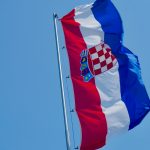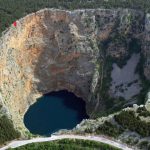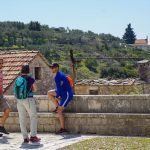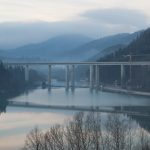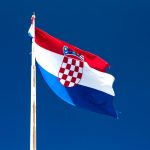Based on her previous work, NASA invited Ivona several years ago to join their Ocean Ecology Lab and work on developing a new sophisticated satellite whose launch is planned for 2022
NASA’s timelapse video showing changes in the seasonal cohabitation of the plant world and the Earth’s surface in the past 20 years is by far the most watched video of the American space agency. In the past week since it was published, it has been viewed over 1.5 million times, and although full of fascinating satellite images which make the expansion and retraction of green surfaces seem like the Earth is breathing, the main star of this popular video is Rijeka native Ivona Cetinić, as Novi List wrote on November 27, 2017.
The video showcase the results of complex optical satellite measurements which define what takes place each season with plant life on land and sea, while Ivona appears as a narrator and one of the currently most significant oceanographers with NASA, specialised in optical measurements of the biology of phytoplankton. The video also drew the attention of the largest global media, so Ivona appeared last week in a lengthy CNN show where she explained to the audience this fascinating earthly part of NASA’s research. This was not the first time the Croatian scientist represented NASA in the media, which is no surprise as she is currently heading one of the largest current oceanography projects of this largest space agency and one of the leading scientists in the Ocean Ecology Laboratory in NASA’s Goddard Space Flight Center.
Ivona’s road to NASA is an excellent example of a swift career which the most talented scientists can achieve. Near the end of the biology studies at Zagreb’s Faculty of science, as a member of prof.dr. Damir Viličić’s lab, she took part in the international project Dolce Vita which observed the interaction of geophysical and biological processes in the Adriatic Sea. The American part of the team applied bio-optics methods, using light to measure processes in the sea.
“The presence of various particles also causes changes to light, thus the sea colour as well, which can be measured with instruments in the sea and with satellites. Satellites use the reflection of sunlight form the sea surface, while instruments in the sea have a built-in light and use a similar principle to make measurements underneath the surface,” explained Ivona.
These optical measurements can be sued by scientists to find how many phytoplankton are in the sea, as well as carbon, various nutrients and chemicals they need to grow. The then relatively new method, much faster than the previous filtering of water samples, fascinated the Rijeka native who was interested in a combination of physics and biology from the start of her studies. Prof. Burt Jones form the American team then invited Ivona to a doctorate study at the Southern California University, where she continued to study phytoplankton, working with underwater robots and studying biological processes such as phytoplankton bloom near California shores. Upon completing her doctorate studies she transferred to the University of Maine, where in her post-doctorate studies she used the same methods to study more global problems, biological processes in oceans, mostly in the northern parts of the Atlantic Ocean. The focus of her research was the way phytoplankton changes the circulation of carbon in the atmosphere and on the planet surface.
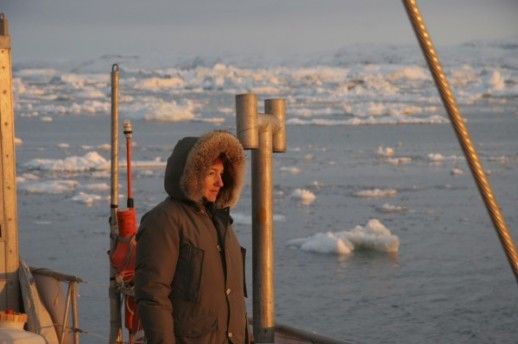
“Phytoplankton, just like plants on land, consume carbon dioxide form the atmosphere and turn it into sugars needed to grow. I am interested how various types of phytoplankton will influence the further circulation of carbon.”
Some phytoplankton will be consumed by fish which will then ‘blow’ this carbon dioxide back into the atmosphere. Some phytoplankton will die on their own and fall to the bottom of the ocean, meaning that CO2 is removed from the atmosphere for the next several hundred years.
“The sea attracts in various ways the same amount of carbon dioxide from the atmosphere just like eco systems on land and it is important to know what happens to it afterwards. If phytoplankton were to disappear, then the rise of carbon dioxide in the atmosphere would be much greater. What prevents this are forests and oceans. Today we have a very good understanding of the differences between various species of phytoplankton. The next step is to try to ascertain differences and changes tide to the carbon path,” Ivona explained. The reason is clear – if phytoplankton changes, the entire eco system changes.
He work did not go unnoticed, so in the past several years NASA invited her to join their Ocean Ecology Lab and work on developing a new sophisticated satellite whose launch is planned for 2022. The existing satellite, Ivona jokes, is like an old Nokia phone, and the new one should in comparison be like the new iPhone. It is currently hard to differentiate types of plankton in certain areas based on satellite images, and the new resolution should enable this, allowing scientist to see more clearly the connection between phytoplankton and the carbon circle.
The development of a new satellite is one of the reasons why NASA initiated this past August a large five-year programme EXPORT, meant to study the influence of organic matter synthesis from carbon dioxide on the carbon circle on Earth, and thus on climate change. The programme is valued at 75 million USD and encompasses two large experiments – one in the Pacific Ocean, the other in the North Atlantic and entails top notch equipment, logistics in view of platforms, ships, airplanes and underground robots. Ivona is in charge of the scientific coordination of hundreds of scientists who will take part in it, as well as the specially complicated research dynamic.
It is not hard to conclude that working in the conditions provided by NASA is a dream come true for an oceanographer. “We do things that are on the edge, shifted science. If I have an idea, not matter how ‘wild’ it may be, I have the space, time and money to develop it. This NASA institute is like a large university, genius scientists and genius engineers working together to develop new methods and equipment. At the first meeting with engineers I had the impression I was sitting with Captain Picard and listen to Star Trek terminology. But by now I have learned quite a bit about engineering,” says Ivona, one of the few women in NASA working in this field of science.
At the last field trip in the Pacific, she recalls, her team tested out three, four new technologies to monitor phytoplankton and measurements of carbon sent to the bottom with it. Among other things they used a broken iPhone to place a camera in, placing it on an underwater platform going to great depths during 48 hours, and for the first time recorded a ‘rain’ of dead phytoplankton falling to the sea bottom. The successful improvisation will now be used to construct a real camera.
Asked if all this means NASA was not denied funds to research life on Earth and climate change, Ivona diplomatically answered that as an American state agency employee she is not authorised to discuss these topics.
She recently tested crazy idea on board the Schmidt Institute ship, whose owner is the former CEO of Google Eric Schmidt. Ivona was the chief scientist on that project too, and the private institute dealing with sea research made sure the participants had absolutely everything needed to get the best results. In such conditions, she says, it is not hard to work on a ship 20 hours per day for a month.
The Rijeka scientists has been living with her American husband, also a scientists, and their three-year old son in the suburbs of Washington. Life in the US capital is quick, she says, but not unpleasant. Everything is full of science and culture, and the city is dominated by a multi-cultural community. They chose to live in the suburbs because of their son – primarily so he could enjoy more, but also so they could have a garden and grow their own fruits and vegetables. Ivona admitted she tried returning to Croatia some time ago, but she found no conditions for her specialisation and research type.
But she did not break her scientific bonds with Croatia. Besides cooperating with scientists from the University of Zagreb, she has been working intensively for eight years on a project to bring a large international conference on optical oceanography to Dubrovnik. The conference is mostly Ivona’s ‘child’ and she is heading the organisational committee, due to bring together in October of 2018 representatives of NASA, European, Canadian and Chinese space agencies, including the most important global organisations dealing with satellite technology and oceanography and thus surely contribute to opening new possibilities for Croatian scientists and engineers.
Translated from Novi List.



